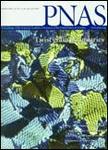版权所有:内蒙古大学图书馆 技术提供:维普资讯• 智图
内蒙古自治区呼和浩特市赛罕区大学西街235号 邮编: 010021

作者机构:Univ Alabama Dept Anesthesiol Birmingham AL 35233 USA Univ Alabama Ctr Free Rad Biol Birmingham AL 35233 USA Univ Alabama Dept Biochem & Mol Genet Birmingham AL 35233 USA Univ Republ Fac Ciencias Secc Neurociencias Montevideo 11200 Uruguay
出 版 物:《PROCEEDINGS OF THE NATIONAL ACADEMY OF SCIENCES OF THE UNITED STATES OF AMERICA》 (美国国家科学院汇刊)
年 卷 期:1999年第96卷第11期
页 面:6365-6370页
核心收录:
主 题:氨基酸序列 结合部位 细胞膜通透性 动力蛋白/代谢 微管/生理学 微管/超微结构 一氧化氮/代谢 肽合酶类/代谢 蛋白质加工 转译后 微管蛋白/化学 微管蛋白/代谢 肿瘤细胞 培养的 酪氨酸/类似物和衍生物 酪氨酸/代谢 人类
摘 要:NO(2)Tyr (3-Nitrotyrosine) is a modified amino acid that is formed by nitric oxide-derived species and has been implicated in the pathology of diverse human diseases. Nitration of active-site tyrosine residues is known to compromise protein structure and function, Although free NO(2)Tyr is produced in abundant concentrations under pathological conditions, its capacity to alter protein structure and function at the translational or posttranslational level is unknown. Here, we report that free NO(2)Tyr is transported into mammalian cells and selectively incorporated into the extreme carboxyl terminus of cu-tubulin via a posttranslational mechanism catalyzed by the enzyme tubulin-tyrosine ligase, In contrast to the enzymatically regulated carboxyl-terminal tyrosination/detyrosination cycle of alpha-tubulin, incorporation of NO(2)Tyr shows apparent irreversibility, Nitro-tyrosination of alpha-tubulin induces alterations in cell morphology, changes in microtubule organization, loss of epithelial-barrier function, and intracellular redistribution of the motor protein cytoplasmic dynein, These observations imply that posttranslational nitrotyrosination of Lu-tubulin invokes conformational changes, either directly or via allosteric interactions, in the surface exposed carboxyl terminus of cu-tubulin that compromises the function of this critical domain in regulating microtubule organization and binding of motor-and microtubule-associated proteins. Collectively, these observations illustrate a mechanism whereby free NO(2)Tyr can impact deleteriously on cell function under pathological conditions encompassing reactive nitrogen species production. The data also yield further insight into the role that the alpha-tubulin tyrosination/detyrosination cycle plays in microtubule function.